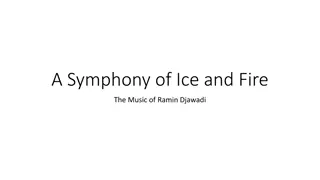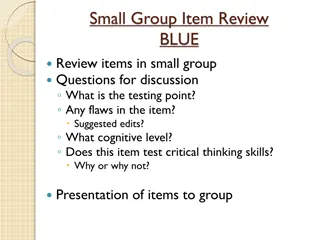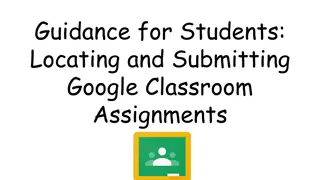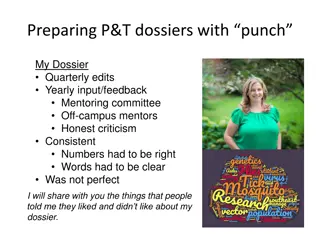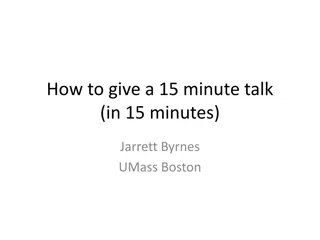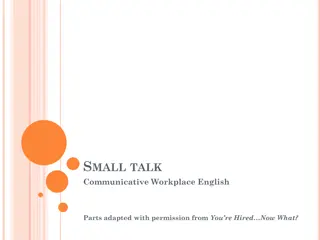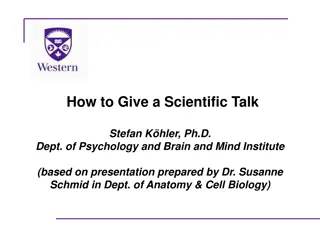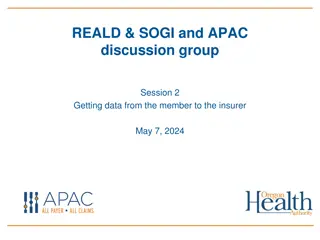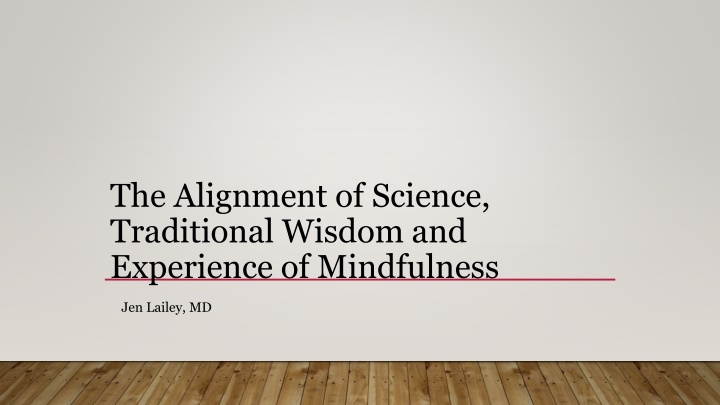
Mindfulness: Science, Wisdom, and Experience | Jen Lailey, MD
Explore the alignment of science, traditional wisdom, and mindfulness experience in this insightful presentation by Jen Lailey, MD. Discover the essence of mindfulness, common misconceptions, and personal experiences shared by the presenter. Learn to differentiate identification of thoughts and emotions, and gain a deeper understanding of the transformative power of mindfulness.
Uploaded on | 3 Views
Download Presentation

Please find below an Image/Link to download the presentation.
The content on the website is provided AS IS for your information and personal use only. It may not be sold, licensed, or shared on other websites without obtaining consent from the author. If you encounter any issues during the download, it is possible that the publisher has removed the file from their server.
You are allowed to download the files provided on this website for personal or commercial use, subject to the condition that they are used lawfully. All files are the property of their respective owners.
The content on the website is provided AS IS for your information and personal use only. It may not be sold, licensed, or shared on other websites without obtaining consent from the author.
E N D
Presentation Transcript
The Alignment of Science, Traditional Wisdom and Experience of Mindfulness Jen Lailey, MD
Purpose of this presentation: To explore some of the neuroscience literature on mindfulness To connect this science to traditional and modern mindfulness teachings To begin to develop a better understanding of what is actually happening in the brain when we practice mindfulness
What is Mindfulness? Mindfulness is the awareness that emerges through paying attention on purpose, in the present moment and non-judgmentally to things as they are (Williams, Teasdale, Segal, and Kabat-Zinn, 2007). Learning to identify when self related thoughts, emotions and body sensations are happening and to differentiate identification of them from identification with them.
More from JKZ Mindfulness represents a new way of being in relationship with yourself, one that s catalytic of a new way of ongoing learning and healing. The transformation comes with the understanding that you are not your thoughts about yourself. You are far far bigger, more nuanced and multidimensional than who you think you are, the story of you
NOT a relaxation exercise, sometimes the opposite happens NOT a test of concentration (the nature of the mind is to wander) Common Misconceptions of Mindfulness NOT a way to avoid difficulty (in fact it brings us closer to it initially) NOT about achieving a different state of mind (it is about settling into our current experience in a relaxed, alert, openhearted way) NOT about clearing the mind
My experience of mindfulness Became more aware of my own suffering/anxiety/stress/reactivity during medical training Came across MBSR in1999. Found the practice VERY challenging but the concepts felt liberating and true. Inconsistent practice until 2012. At that time practicing family medicine at LU clinic and seeing a lot of students struggling with mental health problems. Read about MBCT. It seemed to speak so clearly to the suffering I saw in others and the suffering I experienced in myself. It seemed to offer a path. Took MBCT teacher training in 2012 and have had a consistent practice since then.
My experience of mindfulness continued. Generally speaking I still suffer but take it less personally I worry less, I feel more connected to myself and others, I feel more at peace, I feel more compassion and gratitude, I can regulate my moods much better, I have much more self- acceptance I have much more awareness of and choice around my actions Not magic. No escape. No better life . Still wish for this. More open to being touched by life
The Science Emotion regulation Concentration Default mode network
A summary of the neuroscience literature: Both dispositional and intentional mindfulness activate areas of the brain typically known to be involved in the normal processes of emotion regulation. There is emerging evidence that engagement of intentional mindfulness deactivates the default mode network of the brain, which has been found to correlate with increased self-referential processing and to be overactive during the experience of rumination and worry. Engagement in intentional mindfulness activates areas of the brain that are associated with focused attention on present moment sensory experiences. The means by which intentional mindfulness meditation may facilitate psychological well-being is by encouraging a detachment of narrative-focused thought from interoceptive experience. Wheeler, M.S, Arnkoff D.B., and Glass C.R. (2017) The Neuroscience of Mindfulness: How Mindfulness Alters the Brain and Facilitates Emotion Regulation. Mindfulness, 8: 1471-1487
Emotion regulation: The neurobiology of dispositional mindfulness Decreased activity in the amygdala Increased volume of the insular cortex (associated with increased interoceptive awareness) and this increased awareness of states leads to ability to regulate (top-down) Increased activation in regions of the PFC that can down-regulate amygdalar response to negative emotion inducing stimuli Strong negative relationship between activity in the PFC and R amygdala during labelling of images that generate negative emotion. Suggests that labelling emotions could allow mindful people to detach from the emotion and therefore attenuate the affect arising from stimuli
Mindfulness and Emotion Regulation
Neural correlates of attention in Mindfulness Practitioners Better able to attend to and detect errors AND better able to detach their experience of the error from any emotional reaction associated with making the error Improved sustained attention in part due to improved self-regulation of attention Greater cortical thickness in areas of the brain thought to be important for attentional control (PFC).
Neural Correlates of Interoception and Sensory Processing Greater cortical thickness in areas of the brain involved in sensory processing (dorsal R somatosensory cortex) and the incorporation of sensory information in the appropriate emotional context (R anterior IC)
Self-Referential Processing & The Default Mode Network 2 kinds of self-referential processing in which humans engage: 1. Present moment self-related processing: Associated with activity in the R somatosensory cortex and IC-associated with mindfulness (increased ERPs in these areas even after an 8 week MBCT treatment protocol) Narrative self-related processing: 2. Associated with activity in the medial PFC-associated with mind-wandering and rumination
The Default Mode Network Two main areas of the brain that appear to generate the default mode of human attention; the MPFC (medial prefrontal cortex) and PCC (posterior cingulate cortex) Greater activation is seen in these areas during rumination, anxiety and depression Associated with attentional lapses, anxiety, ADHD and Alzheimer s disease Frontal gamma power increases during rumination while posterior gamma power is associated with greater sensory awareness and attention Evidence suggests that mindfulness practitioners may be able to experience negative emotions and sensations without adding further negative valence brought on by past experience or concern for the future, a skill that is critical for psychological health
Self-focused (blue) vs. Open Awareness (red) Conditions following 8 weeks of MT (Farb et al. 2007)
Mindfulness and the Brain: A Summary
More of a philosophy than a religion A philosophy that has informed many ancient cultures Buddhism The Buddha was not a god, nor did he claim to be. He was a man who taught about suffering based on his explorations of philosophies of his time and his own careful observation of experience
Buddhist Teachings: A Summary The four noble truths: 1. Life is suffering 2. Suffering is caused by attachment (impermanence, non-self) 3. One can learn to be free of suffering 4. There is a path to free oneself of suffering Understanding these truths takes years of practice. The point is to find these things out for oneself rather than just believe them
Why meditation? Vipassana (Insight) Laboratory for understanding suffering Helps us to create quality conditions of the mind (7 factors of awakening) and weakens maladaptive coping mechanisms Develop concentration and observing stance The point is to take this insight from the cushion into our lives
Secular Mindfulness Exploring mindfulness and what it means for those of us in a non-Buddhist culture Buddhist philosophy without any of the dogma, icons and other cultural expressions First form of it was brought to the West by Jon Kabat-Zinn (MBSR) Now many forms of it (MBCT, MSC, smartEducation, MB-EAT, etc.)
Secular mindfulness and Buddhist practice Lots of overlap, difference is in depth Start where you are, no requirement to go all the way Mindfulness programs are a launching pad In common with mindfulness training, insight meditation retreats teach skills that help us respond more effectively to difficult emotions and painful feelings. But such retreats go further. This path seeks not simply to equip us with better skills to cope with suffering but, more radically, to develop the understanding that will uproot the basic misperceptions which underlie all our sense of discontent, and disconnection from others.
Recognize and acknowledge and label emotions Explore the felt sense of emotions in the body (interoception) Non-judgment of emotions, they are not you, not something to fix Mindfulness guidance related to emotion regulation Emotions are just another object in the field of awareness, a phenomenon By intentionally shifting attention from self-narrative/ stories to observing phenomenon, especially in the body, one can learn to be with difficult emotions By directing attention to neutral stimuli or ground (the breath, points of contact) one can learn to regulate and settle
Mindfulness guidance related to attention Intention to bring attention to a particular object in the field of awareness Watch what happens in the mind as we try to do this In seeing the habits of mind for what they are we can learn to let them go In letting go of the habits of mind and not feeding them our minds eventually settle on our intended object We develop increased awareness of the wandering mind and increased skill with redirecting attention
Bring Meditation cycle attention to chosen field of awareness Coming back Seeing where the mind has gone Notice when no longer attending
Mindfulness guidance related to the Default Mode Network Encouraged to see self-related narratives and habits of mind for what they are Learn to have choice about whether to attend to these habits of mind or shift attention elsewhere (i.e., sensation) Learn to shift relationship to rumination Learn to recognize what mode of mind one is in and learn to shift away from DMN
Doing vs. Being Modes of Mind Doing mode Being mode Automatic pilot Living with conscious awareness and choice Relating to experience through thought Directly sensing experience Dwelling on and in the past and future Being fully in the present moment Needing to avoid, escape or get rid of unpleasant experience Approaching unpleasant experience with curiosity Needing things to be different Allowing things to be just as they already are Seeing thoughts as true and real Seeing thoughts as mental events Prioritizing goal attainment Sensitivity to wider needs
What is wrong with doing? The doing mode is how we have survived as a species, how we feed ourselves, how we solve concrete problems It is what our big brains are good at and how we have been conditioned to use them. BUT Habitually problem solving gets us into trouble because we can t solve every problem. Then what? (God) grant me the serenity to accept the things I cannot change, the courage to change the things I can and the wisdom to know the difference Serenity Prayer
A ROSE IS A ROSE IS A ROSE Is it just a reminder of lost love or a suggestion that you should plant more roses? DMN disconnects us from being available for the richness of experience, prevents us being nourished by it, need to look to more and more stimulating experiences to make us "come to our senses" Freud suggested that the purpose of so much of our thinking is to isolate us from the flow of gratifying experience To let go into the flow means accepting some difficult truths
Mindfulness Exercise/Meditation Practice See for yourself









